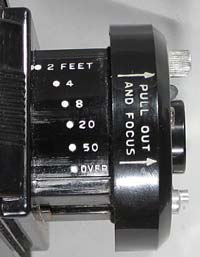Zenith Comet
Specification

| Manufacturer | : | Zenith |
|---|---|---|
| Produced | : | 1947 |
| Classification | : | Medium Format |
| Body Type | : | Extending Body |
| Construction | : | Plastic |
| Film Type | : | 127 |
| Film Width | : | 46mm |
| ImageSize | : | 1⅝ x 2¼ in |
| No. of Images | : | 8 |
| Lens Type | : | Meniscus |
| Focal Length | : | 60mm |
| Focus Type | : | Pull out lens mount to focus |
| Focal Range | : | 2ft - inf. |
| Aperture Type | : | multihole |
| Aperture | : | f/16, f11 |
| Shutter Type | : | Rotary |
| Shutter Speeds | : | B, I*(1/50sec) |
| Size (w x h x d) | : | 73 x 132 x 73 mm |
| Weight | : | 200g |
| * Measured on this camera | ||
Art Deco Credentials
![]()
Limited: Minor and insubstantial
- Designed after the main Art Deco period
- Plastic body with linear raised pattern surrounding camera
- Body embossed with leather style surface
- Chrome film advance knob
- Chrome catch for back
Description

The Zenith Comet is completely distinct form of camera which features full frame images of 2¼ x 1⅝ in. on 127 film. It is constructed of plastic with a metal faceplate with a rather endearing depiction of a comet(shooting star) on it. The film plane is curved. It has an adjustable aperture giving both f/11 and f/16 settings. It also has both instantaneous and time exposure settings. The Comet requires pre-arming of the shutter by turning a setting knob clockwise until it latches. There are two separate release buttons, one for instantaneous and one for timed exposure.
The most interesting feature of the Comet is that the focussing distance is set by pulling out the lens barrel. As the lens barrel slides out, the focussing marks are revealed. This allows the camera to focus all the way from 2ft to infinity.
The Comet can be used in either a vertical or horizontal orientation although it seems to be designed to favour portrait mode. Above the lens barrel is the viewfinder looking through the camera body.
Advertising material of the day points to it's hinged cover, unbreakable case, 'no-jar' shutter and optically ground lens.
How to Use
This camera takes 127 film which is still available from select outlets - search for 'Rera Pan 100-127' which is a black & white film. For those photographers in the UK, try Nick & Trick photographic services. If you want to use a particular type of film which is not available commercially, then you can cut your own 127 film from any 120 film. See my page on 'How to cut 127 film from 120 film'.
If you don't want to bother with an exposure meter, follow the guide shown. It is based on the 'Sunny 16' rule. Film is so forgiving and will produce acceptable results even when overexposed by 2 or 3 stops or underexposed by 1 stop.
Remember that the exposure guide in the camera user manual may not be helpful as it is based on the use of old film with a low ISO value.
The table assumes that the sun is at least 30 degrees above the horizon - that's 10am - 5pm on a summer's day (May-August) in the UK.
This camera has an aperture of f/16 and a shutter speed is 1/50s.
As the shutter speed is only 1/50s, it is advisable to try to hold the camera against a wall or other solid object. For quick snapshots, hold it firmly against your face.
Using ISO 100/125 film - shutter speed 1/50s
| Weather Conditions | Shadow Detail | Aperture | Exposure |
|---|---|---|---|
 Sunny SunnySnow/Sand | Dark with sharp edges | f/16 | +2 Stop Overexposed Acceptable |
 Sunny Sunny | Distinct | f/16 | +1 Stop Overexposed Acceptable |
 Slight Overcast Slight Overcast | Soft around edges | f/16 | Good |
 Overcast Overcast | Barely visible | f/11 | Good |
 Heavy Overcast Heavy Overcast | None | f/11 | -1 Stop Underexposed Acceptable |
 Open Shade Open Shade/Sunset | None | f/11 | -2 Stop Underexposed Unacceptable |